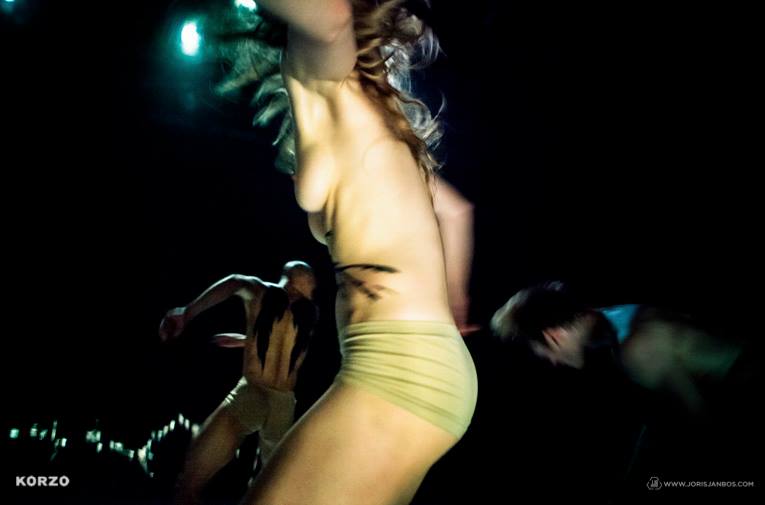More than 10,000 lines of verse comprise Englishman John Milton's poem Paradise Lost (1667). It cannot be easy to capture that in an hour-long dance performance and yet that is what choreographer Samir Calixto set out to do. Earlier, the young Brazilian cut his teeth on Schubert's Winterreise and Vivaldi's Four Seasons. On Friday, he opened the CaDance festival in The Hague with Paradise Lost.
It is dark on stage, very dark. In slowly swelling sounds, we see the silhouette of a curved back with wings in a spotlight. That spotlight gets higher and higher, or the winged person falls deeper and deeper. Then the shadow becomes Samir Calixto himself, dancing with two black wings tattooed on his back, sometimes combative, sometimes torn apart by stronger forces. He represents the fallen angel Lucifer - only he prefers not to call it that himself, and there a problem arises.
Milton's epic describes the fall of the rebellious angel from heaven, and how it then manifests itself as a serpent in paradise. In that guise, he tempts Eve to eat from the tree of the knowledge of good and evil - and the fall and banishment from paradise have become inevitable.
The transformation of Lucifer into the serpent is not a common occurrence in Christianity and thus needs some explanation. But instead, Calixto has decided to make it more complicated. His three characters may not be called Adam, Eve and Lucifer, but 'he', 'she' and 'it'. In that trinity, 'he' and 'she' stand for harmony, 'it' for disruption and rebellion -not necessarily evil. The role of 'it' in Calixto is reminiscent of Herman Hesse's Demian, in which the main characters mirror the biblical Cain. Cain, fratricide, but also the one who actively changes the course of things.
The choice to let the characters be free of name as well as moral value (good or evil) makes the play difficult to understand without knowledge of Milton's work. The play aims to raise questions: is there a good and evil? Is rebelling against harmony bad? What should the role of religion actually be? But to make sense of that extra layer, the audience must first know the essence of Milton's epic, and you can't just assume that. Although, with some guessing, a lot can be interpreted. For instance, the tattooed wings at 'it' find their equivalent in the tree (of knowledge?) on the belly and back of 'him' (Quentin Roger) and 'her' (Ewa Sikorska).
What remains is a beautifully danced, sometimes haunting and sometimes moving piece. Roger and Sikorska move in undulating unison, while Calixto challenges balance with fierce impulse movements and dogged "Ts!" sounds. Initially he does so from behind the mirrored, semi-transparent backdrop, later he stands on the floor to carry one or both partners along in his rebellion.
When 'he' and 'she' finally fall, 'it' is already no longer on stage. Both fight in vain against the light of a strong mockery. Perhaps the angel with the flaming sword, driving the fallen from paradise under heavy thunder. From that broken state, they seek a new beginning.
Recently, Samir Calixto has been experimenting a lot with movement from breath and sound ejection. He also likes to play with light sources, which in Paradise Lost sometimes almost take on the character of a character. Unfortunately, the stage is shrouded in twilight darkness more often than necessary, and this tiring after a while.
The sound design is also on the heavy side. British-The Hague-based Kate Moore composed 'No Man's Land' for Paradise Lost, performed by four members of the Amsterdam Cello Octet. Penetrating, subtle music, which chafes and threatens. Harmen Straatman combined it with an existing fragment by Knaifel and lots of atmospheric sounds. Calixto originally considered using a Led Zeppelin song alongside Moore's piece; I'm curious how that would have turned out.
But surely Paradise Lost has the most to gain from greater clarity. What is wrong with a one-paragraph summary of Milton's epic on the programme sheet? Then the viewer has a point of reference and there is plenty left to philosophise from there.
Seen: Theatre aan het Spui, The Hague, 30 January 2015. Dutch tour 26 February to 28 April. Watch the trailer on YouTube
Also seen on CaDance: Strike Root of Nederlands Dans Theater and My Private Odyssey By Club Guy and Roni.

